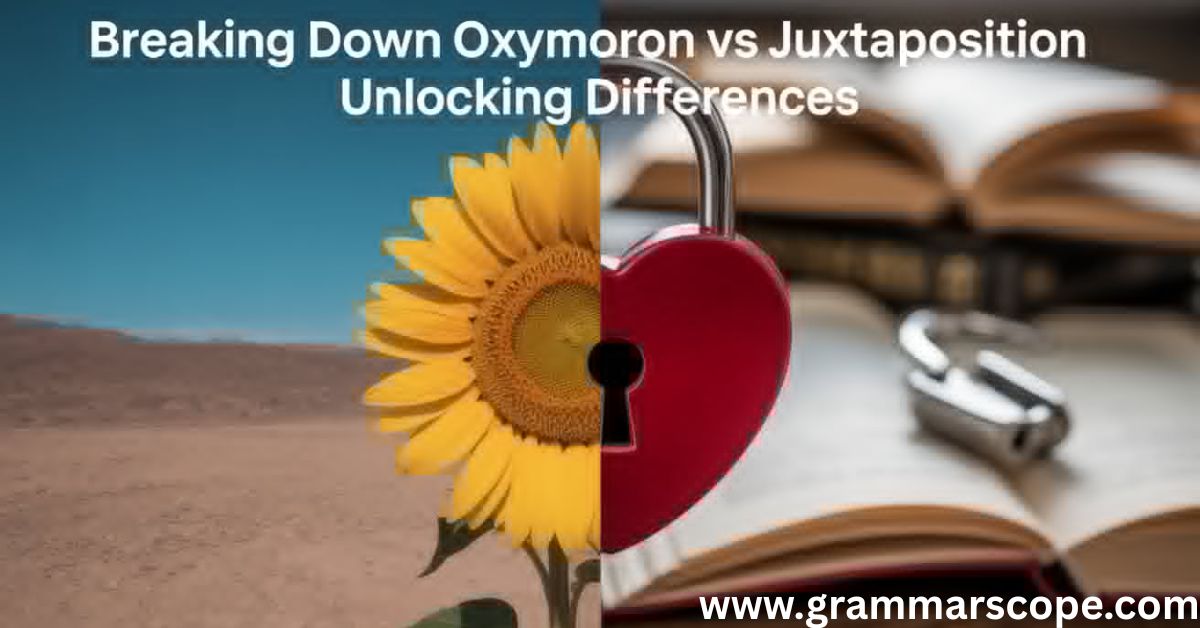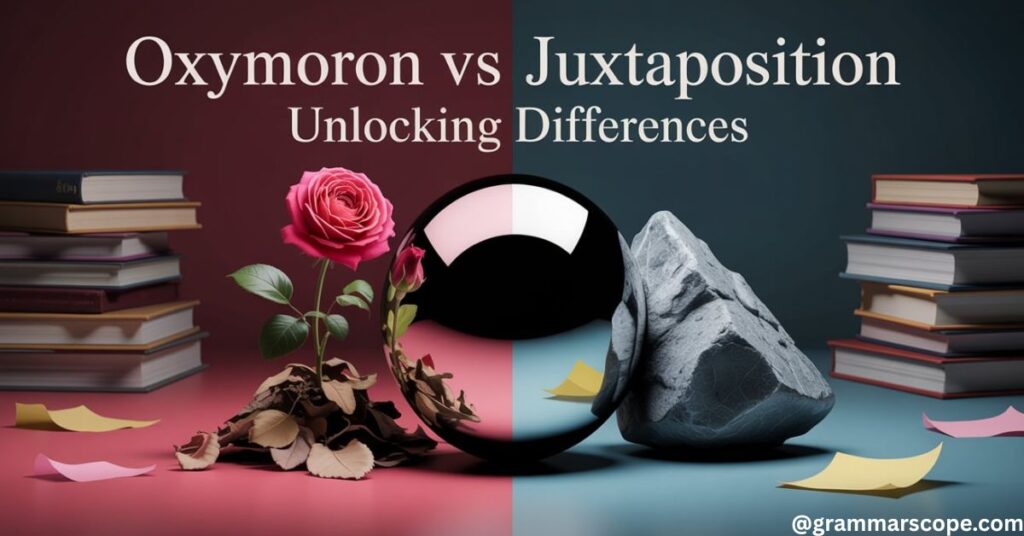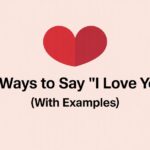Ever noticed how some expressions seem to contradict themselves, like the phrase bittersweet. Or how a serene landscape might be used in a story right after a violent confrontation. These are clear examples of oxymoron and juxtaposition in action. Both tools rely on contrast, but they operate in very different ways. The difference between Oxymoron vs Juxtaposition Unlocking Differences is essential for anyone interested in the mechanics of powerful writing and storytelling. Words can be tricky sometimes they clash, other times they stand side by side, creating sparks that catch your attention.
Oxymorons and juxtaposition both play with contrast, but they do it in very different ways. If you’ve ever wondered how these two literary tools differ or how to use them without mixing them up, you’re in the right place. Let’s break down these fascinating devices and see how mastering them can make your writing pop.
What Exactly Is an Oxymoron in the Context of Language and Literature?
An oxymoron is a concise phrase made up of two words that seem to contradict each other. It’s an intentional clash that creates a fresh, often thought-provoking meaning. Oxymorons are used to express nuanced emotions or highlight ironic situations by combining opposites in a surprisingly meaningful way.
These phrases are often poetic and carry emotional weight. Take bittersweet, for example, it captures the simultaneous joy and sorrow of a goodbye. Other examples include “deafening silence,” “living dead,” and “open secret.” These combinations may appear confusing at first glance, but their power lies in the deeper meaning they convey. Literature, pop culture, branding, and even political speech often use oxymorons for their rhetorical punch. Shakespeare’s plays are filled with them. Juliet’s line in “Romeo and Juliet Parting is such sweet sorrow perfectly illustrates how a contradiction can express layered emotions in just a few words.
Defining Juxtaposition and Its Impact on Storytelling and Visual Communication
Juxtaposition is a broader concept. It involves placing two contrasting elements side by side to highlight their differences. This device doesn’t always rely on direct contradiction; instead, it uses proximity to create meaning. The contrast might appear in settings, characters, themes, or even visual elements.
Writers and artists use juxtaposition to build tension, enrich themes, or prompt critical thought. In novels, this might mean introducing a cheerful character in a grim environment or showing hope amid despair. In film, a director might cut from a funeral to a birthday party to jolt the audience emotionally.
Consider Charles Dickens’ famous line in “A Tale of Two Cities”: “It was the best of times, it was the worst of times.” This sentence sets the tone for the entire novel through thematic juxtaposition. In John Steinbeck’s “Of Mice and Men,” the mental simplicity of Lennie is frequently juxtaposed with the harshness of the world around him, deepening the novel’s emotional impact.
Breaking Down Oxymoron vs Juxtaposition Unlocking Differences

To distinguish between Oxymoron vs Juxtaposition Unlocking Differences, it helps to examine their format, scope, and intent. Oxymorons are micro-level devices, tight phrases packed with internal contradiction. Juxtaposition, on the other hand, is macro stretching across scenes, chapters, or visual elements to make a point.
The goal of an oxymoron is often to convey irony, highlight a paradox, or evoke a complex emotion. Juxtaposition builds broader commentary by inviting comparison and contrast over a larger canvas.
Here’s a quick reference to compare the two:
| Feature | Oxymoron | Juxtaposition |
|---|---|---|
| Structure | Short, contradictory phrase | Broader placement of contrasting elements |
| Typical Usage | Poetry, dialogue, slogans | Narrative, visual storytelling, theme development |
| Emotional Effect | Immediate impact, irony, poignancy | Slow build, thematic depth, tension |
| Examples | “Act naturally,” “Clearly confused” | A rich man dining beside a homeless person |
How Authors Skillfully UseOxymoron vs Juxtaposition Unlocking Differences and Emotion
Writers rely on oxymorons when they want to pack powerful meaning into a few words. This is especially effective in poetry and lyrical prose, where rhythm and compact expression matter. A phrase like “cruel kindness” immediately makes the reader pause and consider the emotional layers beneath the contradiction.
In fiction, oxymorons can give characters a more nuanced voice. A hero describing a battle as a “beautiful disaster” reveals conflicting feelings about violence and victory. In nonfiction, they can be used to highlight irony or social paradoxes, such as “legal murder” in discussions about the death penalty.
Marketing professionals also use oxymorons to grab attention. Think of phrases like “original copy” or “organized chaos.” These phrases are memorable and create an intellectual pause, encouraging deeper engagement.
How Juxtaposition Functions Across Storytelling, Media, and Communication
Juxtaposition works over a broader canvas, using contrast not to shock but to enrich. It reveals relationships and differences through placement rather than direct contradiction. For instance, placing two characters with opposing worldviews in the same setting allows their interactions to highlight the story’s central themes.
In novels, juxtaposition helps explore dualities like hope and despair, peace and violence, or love and betrayal. In memoirs and biographies, contrasting early life experiences with later achievements can emphasize personal growth or systemic injustice.
Visual media like film and photography also thrive on juxtaposition. In “The Godfather,” the baptism scene is spliced with violent assassinations. This contrast between purity and brutality creates a chilling narrative tension. Similarly, photographers often place natural beauty next to human decay to evoke commentary on environmental degradation.
Examining Iconic Examples of Both Devices in Literature, Art, and Marketing
Throughout history, both oxymorons and juxtaposition have left their mark on creative expression.
Shakespeare was a master of oxymorons. In “Romeo and Juliet,” the line “O brawling love, O loving hate” uses opposites to convey emotional confusion. These literary contradictions echo the complex nature of love and family in the play.
Modern literature continues the tradition. In Toni Morrison’s “Beloved,” the gentle care Sethe gives her daughter is juxtaposed with the memory of past horrors. This interplay deepens our understanding of trauma and motherhood.
In film, contrast works just as powerfully. Quentin Tarantino often uses cheerful music during violent scenes to create emotional dissonance. This is juxtaposition at its most visceral, unsettling the viewer to drive home a point.
Advertising agencies frequently use oxymorons and juxtaposition in tandem. A product might be described as “seriously fun,” while the imagery shows luxury in unconventional settings. These contrasts not only draw attention but also communicate brand values in a subtle yet effective way.
the Practical Benefits of Mastering These Literary Techniques

Learning to use oxymoron and juxtaposition effectively allows writers, speakers, and creators to craft more engaging and emotionally resonant content. These techniques help shape tone, evoke mood, and build tension without overt explanation. They guide the audience toward reflection rather than handing them a packaged message.
Oxymorons provide clever turns of phrase that can stop readers in their tracks. Juxtaposition adds depth and structure, enriching themes and character development. When to use which can elevate everything from a short story to a brand campaign.
Wrapping Up: Why Oxymoron vs Juxtaposition Unlocking Differences Are Essential Tools for Powerful Communication
Oxymoron and juxtaposition each serve unique roles in the writer’s toolkit. One plays with contradiction within the phrase; the other reveals deeper truths through structured contrast. Both thrive on tension, inviting readers to look beyond the surface.
Mastering these devices empowers creators to make their language more expressive, more precise, and ultimately, more human. In the hands of a skilled communicator, an oxymoron can become a poetic insight, and juxtaposition a revelation.
Whether you’re telling a story, crafting an argument, or designing a campaign, the difference between oxymoron and juxtaposition can transform your message from ordinary to unforgettable.
Keywords Included: oxymoron, juxtaposition, oxymoron vs juxtaposition, difference between oxymoron and juxtaposition, juxtaposition examples, oxymoron examples, contrast in literature, figurative language, rhetorical devices, writing techniques
Frequently Asked Questions About Oxymoron vs Juxtaposition
What is the simplest way to understand the difference between an oxymoron and juxtaposition?
An oxymoron is a two-word phrase that contains contradictory terms, like “pretty ugly” or “deafening silence.” Juxtaposition, on the other hand, involves placing contrasting ideas, images, or characters side by side to highlight their differences across a broader context. Think of an oxymoron as a mini contrast within a phrase, while juxtaposition works on a larger scale within scenes, paragraphs, or entire works.
Can an oxymoron be considered a form of juxtaposition?
Not exactly. While both use contrast to create meaning, an oxymoron is a specific type of contradiction packed into a single phrase. Juxtaposition involves a structural placement of two elements that are not inherently contradictory but become meaningful through their proximity. Oxymorons are more compact and linguistic, while juxtaposition operates on a conceptual or visual level.
Where are oxymorons and juxtapositions commonly used in media?
Oxymorons appear frequently in literature, poetry, song lyrics, political speech, and branding slogans. Juxtaposition is common in film, advertising, photography, novels, and visual storytelling. For instance, an ad might use the oxymoron “seriously playful,” while also using juxtaposition by showing that phrase on an image of a child in a business suit.
Why do authors use oxymorons and juxtaposition?
Writers use oxymorons to convey complex emotions and provoke thought through contradiction. Juxtaposition is used to emphasize contrast, develop themes, and create tension or irony by placing opposites together. Both are powerful tools for deepening narrative impact and guiding the audience toward a richer interpretation.
Are oxymorons considered figurative language?
Yes. Oxymorons fall under the umbrella of figurative language. They rely on non-literal meanings to express deeper truths or emotional subtleties. They also qualify as rhetorical devices because they enhance persuasion and emotional effect in speech and writing.
How can I identify a juxtaposition in a story or image?
Look for scenes, characters, or ideas that are intentionally placed near one another but sharply contrast in tone, appearance, or meaning. A peaceful village scene followed by a brutal war sequence is a cinematic example of juxtaposition. In literature, two characters with opposing values sharing a pivotal moment often represent this device.
Do oxymorons always make sense?
Not always at first. That’s part of their charm. The initial contradiction causes the reader to pause, reflect, and explore the underlying meaning. Some oxymorons, like the living dead, are so familiar that their contradiction feels natural. Others may be more abstract or poetic, depending on context.
Can juxtaposition occur within a sentence?
Yes. Although juxtaposition usually spans larger sections of text or images, it can also happen within a sentence when two contrasting ideas are closely linked. For example, “He smiled through his tears” juxtaposes joy and sorrow within a single action.
How do oxymorons enhance poetry?
Oxymorons give poetry a rich emotional depth in very few words. They help poets express conflicting feelings, highlight irony, or intensify imagery. Shakespeare, Keats, and modern poets alike use oxymorons to build vivid contrasts and sharpen language.
What’s the best way to teach the difference between Oxymoron vs Juxtaposition, Unlocking Differences?
Use concrete examples. Pair phrases like “jumbo shrimp” (oxymoron) with scenes like a wedding held in a graveyard (juxtaposition). Visual examples and short excerpts from literature or film can clearly illustrate how each device functions and why it matters.
Final Thought:Oxymoron vs Juxtaposition Unlocking Differences
In the grand tapestry of language and storytelling, oxymoron and juxtaposition perform a delicate dance—a push and pull of contrasts that breathe life into words and images. The oxymoron condenses complexity into a spark of contradiction, forcing us to pause and unravel the layered meaning hidden within a simple phrase. Juxtaposition, by contrast, stretches this interplay across scenes, ideas, or visuals, inviting us to explore the broader landscape of opposing forces.
Mastering these literary powerhouses isn’t just about knowing definitions; it’s about wielding contrast like a painter uses light and shadow. When you blend the precise bite of an oxymoron with the expansive scope of juxtaposition, you unlock new dimensions in your writing, art, or communication. The result is richer storytelling, sharper insight, and a message that resonates deeply. So, whether you’re crafting a compelling novel, designing striking visuals, or delivering a memorable speech, remember that the secret lies in the harmonious clash that makes meaning memorable. Embrace the power of oxymoron and juxtaposition, and watch your words transform from ordinary to extraordinary.

Emma Olivia is an experienced blogger and the creative mind behind Grammar Scope. With a passion for language and years of writing expertise, she crafts engaging, informative content that simplifies grammar and writing tips for readers worldwide. Emma’s dedication to clear communication and love for the written word shine through every article she publishes, making Grammar Scope a trusted resource for language enthusiasts and learners alike.







